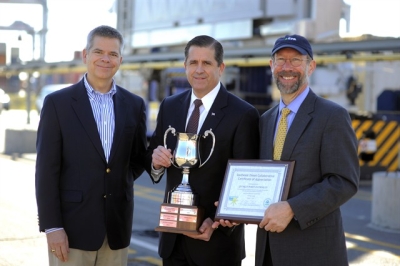
| January 28, 2014 | |
Environmental: Georgia Ports Authority, Mississippi State Port Authority
![]() Print this Article | Send to Colleague
Print this Article | Send to Colleague
The Georgia Ports Authority has won recognition by the Environmental Protection Agency as a leader in reducing carbon emissions, and the Mississippi State Port Authority at Gulfport is joining Green Marine, a sustainability program developed for the marine transportation industry that provides a framework for ports, terminals, shipping companies and shipyards to improve their environmental performance.
EPA Recognizes Georgia Ports Authority for Superior Environmental Efforts
EPA Recognizes Georgia Ports Authority for Superior Environmental Efforts
The Georgia Ports Authority (GPA) has won recognition by the Environmental Protection Agency as a leader in reducing carbon emissions. The Southeast Diesel Collaborative (SEDC), a public-private partnership formed by the U.S. EPA Region 4 office, named the GPA as a Community Leadership Award winner.
The SEDC award is presented annually for projects that best exemplify extraordinary leadership in promoting the goal of the collaborative, which is to improve air quality and public health by reducing emissions from existing diesel engines. The GPA won the Community Leadership Award on the basis of the following technologies:
Electric rubber-tired gantry cranes, developed with input from GPA engineers, use a retractable arm that latches to a conductor rail while the crane is in use over a container stack. When moving between rows, a diesel generator automatically starts at the end of one conductor rail and then stops when the computer-guided arm re-engages with the conductor rail at the next row.
Twenty older diesel RTGs were repowered with funding by EPA DERA grants. The engines ranged from Tier 0 to Tier 2 and were repowered to Tier 4i engines with variable alternators. The variable alternators deliver power as needed, only turning the RPMs required for the current load. Legacy engines run at the constant higher RPMs needed to lift a container. The variable alternators reduce diesel consumption and emissions.
In December 2012, the GPA unveiled its first four electrified rubber-tired gantry cranes. The GPA board recently approved spending $8 million for Phase II of the eRTG project, which will convert 10 additional diesel RTGs to electric power, and install conductor rails at 12 more container blocks. GPA’s transition to an eRTG fleet should be complete by 2024.
The locomotive project retrofitted 11 switch locomotives operating on GPA terminals through an EPA grant to Rail Link, GPA’s rail partner. The private entity retrofitted 1957-1978 locomotives with automatic equipment stop/start units to decrease idling.
"We are pleased to see peer recognition of superior corporate stewardship by organizations that are improving air quality in the region," said Stan Meiburg, EPA’s acting Southeast regional administrator. "Your strategies have involved operations throughout the port and show both a strong commitment by the Georgia Ports Authority to the environment and your desire as a leading U.S. port to use best practices that increase efficiency and save time and money."

Christopher Grundler, left, director, office of transportation and air quality for the U.S. Environmental Protection Agency, and Stan Meiburg, right, acting regional administrator for the EPA’s Southeast Region, present Georgia Ports Authority Executive Director Curtis Foltz, center, an award for environmental stewardship at the GPA Garden City Terminal, Friday, January 17, 2014, near Savannah.
Photo/GPA, Stephen Morton
Gulfport Joins Green Marine
The Mississippi State Port Authority at Gulfport is joining Green Marine, a sustainability program developed for the marine transportation industry that provides a framework for ports, terminals, shipping companies and shipyards to improve their environmental performance.
The port authority plans to work with Green Marine to strengthen the port’s environmental performance by building strong relations with marine waterway stakeholders, and heightening understanding of the marine industry’s activities and environmental benefits.
"Green Marine’s mission is to make the marine transportation industry greener, which ties in with our efforts to make the Port of Gulfport a more environmentally efficient port," said MSPA Executive Director and CEO Jonathan Daniels.
"Green Marine’s mission is to make the marine transportation industry greener, which ties in with our efforts to make the Port of Gulfport a more environmentally efficient port," said MSPA Executive Director and CEO Jonathan Daniels.
"We pride ourselves in the transparency and rigor of our environmental program," explained Green Marine Management Corporation President Raymond Johnston. "Port of Gulfport joining Green Marine clearly reflects a strong commitment towards the greening of their operations. It also demonstrates that the Green Marine environmental program is valid, applicable and scalable for all sizes of ports."
In a Memorandum of Understanding signed at last fall’s AAPA convention (Advisory, October 22, 2013), Green Marine and AAPA agreed to work cooperatively to advance environmental protection at seaports in the Western Hemisphere.
